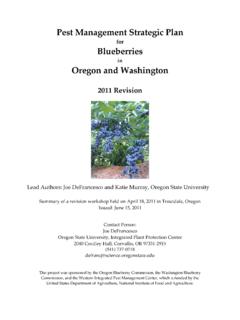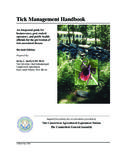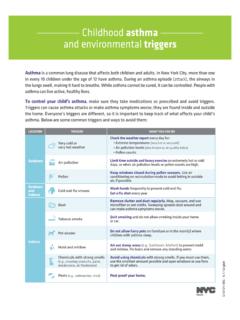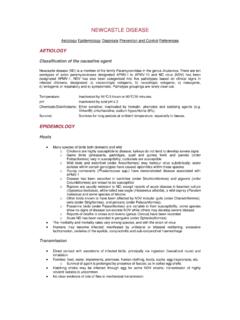Transcription of Pest Management Strategic Plan Christmas Trees …
1 Pest Management Strategic plan for Christmas Trees in Oregon, Washington, and Idaho Lead Authors: Joe DeFrancesco and Katie Murray, Oregon State University Editor: Diane Clarke, University of California, Davis Summary of a workshop held on February 2nd and 3rd, 2009 Aurora, Oregon Issued: August 2009 Contact Person: Joe DeFrancesco Integrated Plant Protection Center Oregon State University 2040 Cordley Hall Corvallis, OR 97331-2915 (541) 737-0718 This project was sponsored by the Western Integrated Pest Management Center, which is funded by the United States Department of Agriculture, Cooperative State Research, Education, and Extension Service. PMSP FOR Christmas Trees IN OREGON, WASHINGTON, AND IDAHO 2 Table of Contents Work Group Members .. 3 Summary of Critical Needs .. 5 Introductory Pages: Process for this Pest Management Strategic plan .. 6 Regulatory Background.
2 7 Christmas tree Production Overview .. 8 Christmas tree Export Markets .. 13 Targeting Pests in Christmas tree 15 Christmas tree Pests Outline .. 17 Major Christmas tree Pests by Crop Stage (Quick Reference List) .. 19 Christmas tree Field Activities by Crop Stage .. 20 Christmas tree Pests and Management Options: I. Major Pests .. 22 a. Insects and Mites .. 22 b. 43 c. Weeds .. 57 II. Major Regulatory Pests .. 65 III. Vertebrate Pests in Christmas tree Production .. 70 IV. Sporadic and Minor Pests .. 74 V. Other Disorders .. 88 References .. 91 Appendices 1. Activity Tables .. 92 2. Seasonal Pest Occurrence Tables .. 93 3. Efficacy Ratings for Insect and Mite Management Tools in Christmas Trees .. 94 4. Efficacy Ratings for Disease Management Tools in Christmas Trees .. 97 5. Efficacy Ratings for Weed Management Tools in Christmas Trees .
3 99 WORK GROUP MEMBERS PMSP FOR Christmas Trees IN OREGON, WASHINGTON, AND IDAHO 3 Work Group Members The following people generously offered their knowledge and skills in the development of this Pest Management Strategic plan for Christmas Trees . Many of them contributed significantly to both the writing and editing of the document. In Attendance at Meeting: Idaho Members: Dave Anderson, Grower, Sandpoint Ranch tree Farm Mike Bauer, Extension Educator, Bonner County, University of Idaho Jennifer Jensen, Extension Educator, Boundary County, University of Idaho John Myhre, Grower, Rusty Gate tree Farm Oregon Members: Mike Bondi, Clackamas County Extension, Oregon State University Paul Borgen, Consultant, Pratum Co-op Ute Chambers, Entomologist, Oregon State University Glenn Fisher, Entomologist, Oregon State University Clair Klock, Senior Resource Conservationist, Clackamas Soil and Water Conservation District Chal Landgren, Extension Christmas tree Specialist, Oregon State University Stan Low, Grower, Highland Farm of Oregon Gary McAninch, Nursery and Christmas tree Program, Oregon Department of Agriculture Pat Malone, Grower Herminio Martinez, Farm Manager, Yule tree Farms Terry Muilenburg, Grower, Green Valley Farms Ed Peachey, Weed Scientist, Oregon State University Mike Ricks, Grower, Cascade Vista tree Farm Kurt Spingath, Consultant, Wilco-Winfield, LLC Vaughn Walton, Extension Entomologist, Researcher, Oregon State University Washington Members.
4 Art Antonelli, Extension Entomologist, Washington State University Gary Chastagner, Extension Plant Pathologist, Washington State University Catherine Daniels, Pesticide Coordinator, Washington State University Franki Porter, Consultant, Wilbur-Ellis Company Dennis Tompkins, Consultant and Certified Arborist, The Evergreen Arborist John Tillman, Grower, Northwest Plantations WORK GROUP MEMBERS PMSP FOR Christmas Trees IN OREGON, WASHINGTON, AND IDAHO 4 Consulting Member from Hawai i: Rob Hollingsworth, Entomologist, USDA Agricultural Research Service Others in Attendance: Joe DeFrancesco, Pacific Northwest PMSP Coordinator, Oregon State University Gina Koskela, Research Assistant, IR-4 Program, Oregon State University Katie Murray, Research Assistant, PMSP Program, Oregon State University Workgroup Members Not in Attendance at Meeting: Rick Fletcher, Benton County Extension, Oregon State University Tom Leege, Grower, Blue Haven tree Farm, Idaho Jim Puffer, Grower, Yule tree Farms, Oregon Mike Stone, Consultant, of Oregon Kirk Stroda, Grower, Stroda Brothers Farm, Oregon SUMMARY OF CRITICAL NEEDS PMSP FOR Christmas Trees IN OREGON, WASHINGTON, AND IDAHO 5 Summary of Critical Needs (Pest-specific and crop-stage-specific aspects of these needs, as well as additional needs, are listed and discussed throughout the body of the document.)
5 Research: Develop economic thresholds for all insects, mites, diseases, and weeds that have a negative effect on Christmas tree growth and production. Verify the efficacy of current systemic insecticides, and identify and evaluate new systemic chemistries for insect and mite Management . Develop effective controls to minimize the occurrence of regulatory pests such as Douglas-fir needle midge, wasps, Douglas-fir twig weevils, and slugs, which can and do impede exports. Research the pros and cons of cover crops in preplanted fields versus established Christmas tree plantations to find the right balance between tree and soil health, and weed and rodent control. Regulatory: Have the Environmental Protection Agency (EPA), the Washington State Department of Agriculture (WSDA), the Oregon Department of Agriculture (ODA), and the Idaho State Department of Agriculture (ISDA) come to a consensus on the regulatory terms referring to Christmas Trees , especially as they relate to pesticide registrations and labels.
6 Maintain the registration of chlorothalonil (Bravo), which is an effective fungicide important to the Christmas tree industry for the Management of many diseases that attack Christmas Trees . Explore further impediments to trade (national or international) with regard to potential regulatory pests, such as the pinewood nematode. Determine existing regulatory pest populations in export markets. Education: Educate growers on pest identification, especially for pests such as aphids, needle casts, and mites. Educate growers on the benefits of developing an Integrated Pest Management (IPM) program for Christmas Trees . Develop a best Management practices (BMP) document for Christmas tree growers that will include BMPs for meeting export market requirements. Establish a forum ( , via an electronic mailing list server) for growers to discuss current problem pests and control strategies.
7 PROCESS FOR THIS PEST Management Strategic plan PMSP FOR Christmas Trees IN OREGON, WASHINGTON, AND IDAHO 6 Process for this Pest Management Strategic plan In a proactive effort to identify pest Management priorities and lay a foundation for future strategies, Christmas tree growers, commodity group representatives, pest control advisors, regulators, university specialists, and other technical experts from Oregon, Washington, and Idaho formed a work group and assembled this document. Members of the group met for 2 days in February, 2009, in Aurora, Oregon, where they drafted a document containing critical needs, general conclusions, activity timetables, and efficacy ratings of various Management tools for specific pests in Christmas tree production. The resulting document was reviewed by the work group, including additional people who were not present at the meeting. The final result, this document, is a comprehensive Strategic plan that addresses many pest-specific critical needs for the Christmas tree industry in Oregon, Washington, and Idaho.
8 The document begins with an overview of Christmas tree production, followed by discussion of critical production aspects of this crop. The remainder of the document is an analysis of pest pressures during the production of Christmas Trees , organized by pest type (insect and mite, disease, weed, vertebrate, and other). Key control measures and their alternatives (current and potential) are discussed. Each pest is mentioned in alphabetical order (not in order of importance), and entries include references to cultural controls (including resistant cultivars), biological controls, and chemical controls (including preplant pesticide treatments) currently utilized for each pest. The biology and life cycle of each pest are described in detail. Trade names for certain pesticide products are used throughout this document as an aid for the reader in identifying these products. The use of trade names does not imply endorsement by the work group or any of the organizations represented.
9 REGULATORY BACKGROUND PMSP FOR Christmas Trees IN OREGON, WASHINGTON, AND IDAHO 7 Regulatory Background Christmas tree growers, and others associated with the industry, recognize the importance of developing long-term strategies to meet their pest Management needs. These strategies may include identifying critical pesticide uses, retaining critical uses, researching pest Management methods with an emphasis on economically viable solutions, and understanding the impacts of pesticide cumulative risk. EPA has completed the risk assessments required under the Food Quality Protection Act of 1996 (FQPA) and continues its reregistration process. With the advent of the FQPA and the subsequent risk assessments, several pesticides have been cancelled or now have reduced or more-restrictive label uses. In addition to the risk assessments and reregistration efforts of EPA, the Endangered Species Act (ESA) may also impact the availability or restrict the use of certain pesticides.
10 The ESA requires that any federal agency taking an action that may affect threatened or endangered species, including EPA, must consult with either the National Oceanic and Atmospheric Administration (NOAA-Fisheries), or the Fish and Wildlife Service, as appropriate. Lawsuits have been filed against EPA alleging the Agency failed to complete this consultation process. One lawsuit resulted in the establishment of buffers for applications of certain pesticides around salmon-supporting waters in Washington, Oregon, and California. Salmon and other threatened and endangered species are located throughout the Christmas tree growing regions of the Pacific Northwest, and there are likely to be further requirements for the protection of these species. The total effects of FQPA and ESA are still transpiring. Clearly, however, new pest Management strategies will be necessary in the Christmas tree industry.







